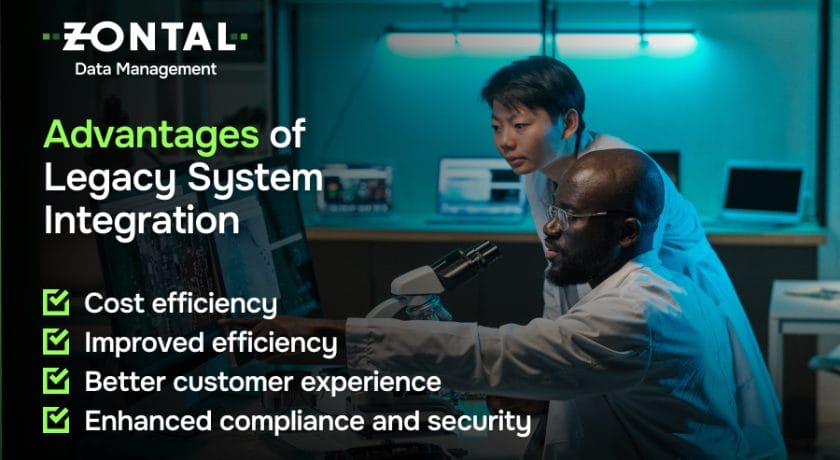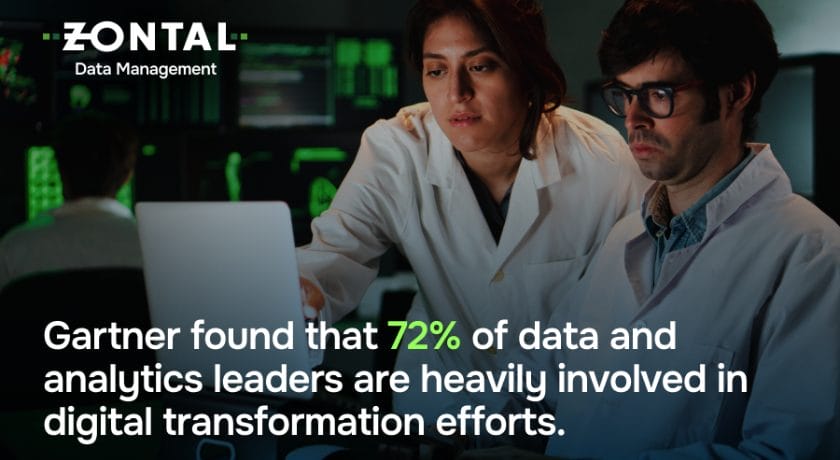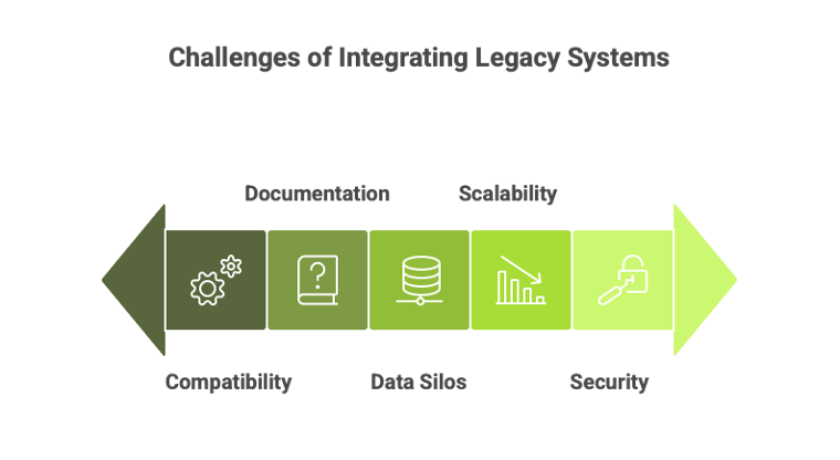Legacy System Integrations: Benefits & Challenges

Legacy System Integrations: Key Takeaways
- The benefits of integrating legacy systems are numerous. They do come with initial operational costs, but are a pathway to long term efficiency, compliance, and scalability.
- Challenges comprise compatibility issues, security vulnerabilities, and documentation gaps.
- ZONTAL can help by seamlessly integrating legacy systems into a unified, interoperable data framework.
McKinsey highlighted that modernizing and integrating legacy systems can slash IT operating costs by up to 30%, all while unlocking agility and paving the way for real-time analytics and automation.
This transformation allows organizations to unify existing technologies into a cohesive ecosystem that delivers greater value and supports next-generation digital services.
In this article, we will:
- Cover the benefits of a legacy system integration
- Explore its common pitfalls
- Introduce how ZONTAL can help organization modernize legacy systems through secure, compliant, and scalable integration solutions
Streamline your scientific data flow with ZONTAL.

5 Benefits of Legacy System Integration
Bridging legacy systems with modern digital infrastructure unlocks powerful gains, driving both day-to-day efficiency and long-term strategic impact.
- Reduced costs: Rather than investing in a full system overhaul, integration enables continued use of existing infrastructure, minimizing capital expenditure while extending the value of prior investments.
- Operational efficiency: Integration eliminates data silos and reduces manual workflows, enabling seamless data exchange between departments and applications. This streamlines processes and accelerates decision-making. These benefits help explain why 72% of data and analytics leaders are actively driving digital transformation initiatives.
- Enhanced customer experience: By consolidating customer-related data from multiple systems into a unified view, organizations can provide more responsive, personalized, and consistent service.
- Stronger compliance and security: Modern integration platforms incorporate up-to-date encryption, access controls, and compliance frameworks. This ensures that legacy environments align with evolving regulatory requirements such as HIPAA or FDA 21 CFR Part 11.
- Better agility and innovation: Integrating legacy platforms supports fast adoption of new technologies while advancing laboratory data standardization across the enterprise.

11 Challenges of Integrating Legacy Systems and How To Tackle Them
Integrating legacy systems with modern IT environments introduces significant technical and operational challenges, particularly in regulated sectors like clinical research pharmaceuticals, and biotechnology.
1. Compatibility With Modern Standards
Legacy systems were often developed using proprietary software or outdated hardware that doesn’t align with modern regulatory IT frameworks.
This makes integration with compliant platforms, those supporting secure APIs or validated data environments, difficult and resource intensive.
In life sciences research institutions, this incompatibility often forces teams to manually reconcile data across platforms, increasing the risk of transcription errors and noncompliance.
ZONTAL bridges legacy and modern infrastructure by offering a vendor-neutral platform that supports over 400 data types and standardized interfaces.
This eliminates the need for custom middleware and enables seamless data harmonization into validated environments.
2. Data Silos Hindering Regulatory Reporting
Isolated data stores disrupt unified access and traceability, both critical for GLP and GMP compliance in pharmaceutical and biotech operations, which require end-to-end documentation of experimental and manufacturing processes.
Disconnected systems also complicate FDA audit readiness and real-time data accessibility.
3. Non-Compliant Data Formats
Legacy data might lack standardized metadata or audit trails, preventing it from being directly migrated to validated systems without transformation.
FDA 21 CFR Part 11 compliance, for instance, mandates secure, traceable, and immutable data, often missing in older system architectures.
ZONTAL can help by:
- Standardizing legacy data into validated, immutable formats suitable for compliant use
- Preserving critical metadata and audit trails, ensuring data lineage and traceability
- Applying time-stamped versioning, aligning archived records with regulatory expectations
- Ensuring long-term readability and preventing obsolescence of valuable historical data
4. Complex Architectures and Middleware Needs
Integrating legacy systems frequently demands custom-built interfaces or middleware that themselves must be validated to ensure they don’t compromise data integrity.
This adds cost and complexity to validation protocols mandated under GMP.
5. Missing Documentation and Institutional Knowledge
Legacy systems often suffer from poor documentation, which undermines validation efforts and jeopardizes regulatory compliance.
- Outdated or missing SOPs and system records make it difficult to demonstrate control or traceability
- Loss of institutional knowledge due to staff turnover can sever understanding of how systems were configured or used, putting compliance continuity at risk.
ZONTAL’s M&A Data solutions address this by preserving and contextualizing legacy system data, even in undocumented environments, ensuring it remains usable, traceable, and compliant long after original system experts have left.
6. Scalability and Performance Deficiencies
Legacy systems often can’t meet performance or data throughput requirements necessary for continuous manufacturing or high-throughput research environments.
This potentially delays time-to-market and compromises regulatory review cycles.
7. Security and Audit Vulnerabilities
Outdated systems might lack essential security controls such as audit trails, access control, or electronic signature capabilities, requirements under FDA 21 CFR Part 11 and essential for GLP/GMP enforcement.
This exposes the organization to inspectional observations or warning letters.
8. High Cost of Maintenance and Validation
Legacy platforms demand ongoing manual oversight and frequent re-validation to maintain compliance.
These efforts drain resources that could otherwise support modernization or compliance automation strategies.
In pharmaceutical manufacturing, for example, every software update to a legacy LIMS must be documented and revalidated to remain GMP-compliant.
In biotech R&D, these cycles slow down the pace of innovation and consume resources better spent on advancing pipeline assets.
With our LIMS Consolidation, organizations eliminate redundant systems and shift to a unified platform with automated validation tracking and centralized updates, significantly reducing compliance maintenance overhead.
9. Disruptions During System Upgrades or Migration
Integration projects often require system downtime, halting data collection, and lab operations.
In regulated settings, these interruptions must be meticulously documented and validated to ensure continuity and data integrity, further increasing the operational burden.
10. Organizational Resistance and Training Needs
Change management becomes critical when transitioning from legacy to compliant systems.
For instance, life sciences organizations implementing electronic record-keeping under FDA 21 CFR Part 11 train their employees on new workflows and key concepts like data integrity, audit trails, and electronic signatures.
11. Data Breach Risks and Security Threats
Legacy systems are prime targets for cyberattacks. With the average data breach now costing $5.17 million, according to IBM, it’s a risk no organization can afford to overlook.
Without ongoing updates or vendor support, these systems lack modern safeguards by design, leaving them highly vulnerable to exploitation.
Most cannot support essential security controls like:
- Multi-factor authentication
- Role-based access
- Strong encryption
Outdated protocols and missing audit trails leave critical systems exposed; one unpatched flaw is all it takes for attackers to breach your entire network.

How To Integrate Legacy Systems
Integrating legacy systems with modern digital infrastructure requires a flexible and scalable solution.
Here are several core approaches to integrating legacy systems within a modern architecture:
- API Wrapping: Encapsulates legacy apps with APIs to enable modern integration without altering original code, facilitating seamless data exchange.
- Middleware Connectivity: Serves as a broker across systems, supporting diverse protocols and data formats for interoperability.
- Enterprise Service Bus (ESB): Provides a unified integration layer to manage data transformation and communication across complex system landscapes.
- ETL Integration: Uses extract-transform-load processes to standardize and migrate legacy data into modern environments for analytics and reporting.
How does ZONTAL fit into this?
ZONTAL makes it easy to connect legacy lab systems with today’s digital platforms.
Its vendor-neutral design and standardized approach to data handling are built specifically for the needs of regulated life science environments.
Simplify data migration and validation with ZONTAL.
Accelerate Your Digital Lab Transformation With ZONTAL
Keeping your trusted systems shouldn’t hold you back from moving forward.
With legacy system integration, you can build a connected hybrid environment that maximizes the value of your existing technology while unlocking the benefits of digital transformation.
ZONTAL offers seamless data management solutions that help life sciences organizations future-proof their data infrastructure:
- ELN Archiving: Preserve and standardize data from outdated electronic lab notebooks in a centralized archive, no need for legacy platform access.
- LIMS Consolidation: Break down data silos by integrating multiple LIMS into a single, compliant, and interoperable environment.
- Mergers & Acquisitions Data: Simplify post-acquisition complexity by harmonizing inherited systems and ensuring data continuity across the enterprise.
Whether you’re phasing out legacy platforms or consolidating after a merger, ZONTAL transforms integration challenges into operational agility.
Extend the value of your existing systems with ZONTAL.
Legacy System Integration: FAQs
What is legacy system integration and why is it important?
Legacy system integration connects outdated or unsupported systems, such as LIMS, ELNs, or instrument software with modern platforms, to enable data continuity, streamline workflows, and maintain regulatory compliance.
Ultimately, it allows organizations to retain valuable historical data while accelerating digital transformation.
What types of legacy systems can ZONTAL integrate?
ZONTAL supports integration for a wide range of legacy environments, including retired or proprietary ELNs, multiple LIMS platforms, instrument file formats, and archival systems.
Our solutions standardize and preserve data while ensuring accessibility and audit readiness across the enterprise.
How does legacy integration impact regulatory compliance (think FDA, GLP, GMP)?
ZONTAL ensures that integrated legacy systems meet compliance standards such as FDA 21 CFR Part 11, GLP, and GMP.
This includes maintaining audit trails, data integrity, user access controls, and traceability during and after migration.
Will integration disrupt our current operations or data workflows?
No. ZONTAL’s integration solutions are designed for minimal disruption. We support phased migration, parallel validation, and automated data capture to ensure business continuity and uninterrupted lab operations during integration.
What are the risks of not integrating legacy systems?
Outdated systems can become liabilities, introducing data silos, security vulnerabilities, compliance risks, and increasing maintenance costs.
Without integration, organizations miss out on interoperability, real-time analytics, and long-term data preservation.
Have more questions about legacy system integration?
 >
> 

